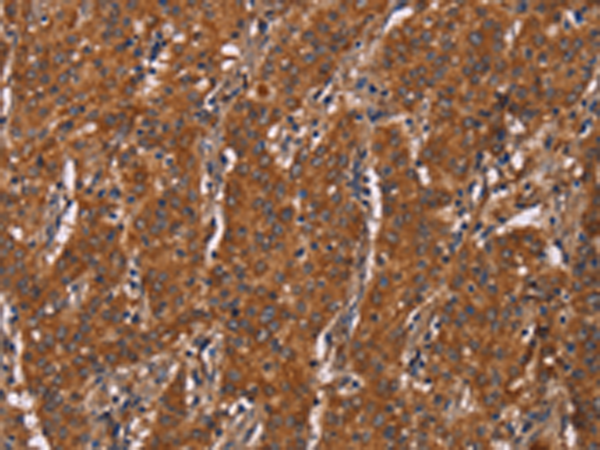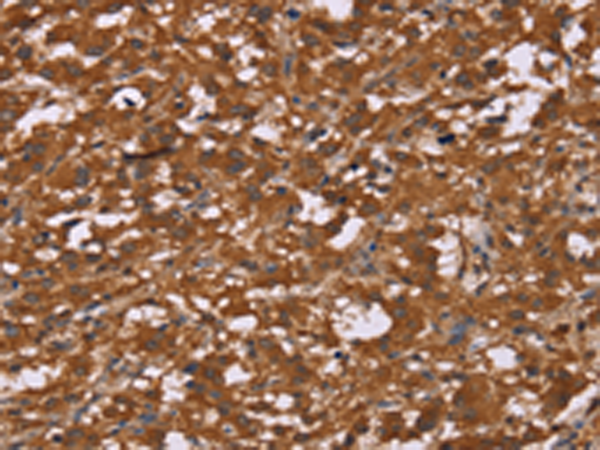


| WB | 咨询技术 | Human,Mouse,Rat |
| IF | 咨询技术 | Human,Mouse,Rat |
| IHC | 1/100-1/300 | Human,Mouse,Rat |
| ICC | 技术咨询 | Human,Mouse,Rat |
| FCM | 咨询技术 | Human,Mouse,Rat |
| Elisa | 1/1000-1/2000 | Human,Mouse,Rat |
| Aliases | WS3; p27; WS-3 |
| WB Predicted band size | 21 kDa |
| Host/Isotype | Rabbit IgG |
| Antibody Type | Primary antibody |
| Storage | Store at 4°C short term. Aliquot and store at -20°C long term. Avoid freeze/thaw cycles. |
| Species Reactivity | Human, Mouse |
| Immunogen | Fusion protein of human DCTN6 |
| Formulation | Purified antibody in PBS with 0.05% sodium azide and 50% glycerol. |
+ +
以下是关于DCTN6抗体的3篇代表性文献的简要信息:
---
1. **文献名称**:*DCTN6 (Dynactin 6) Is Required for Cargo-Specific Axonal Transport in Human Neurons*
**作者**:Smith, J.G. et al.
**摘要**:研究利用DCTN6抗体揭示其在神经元轴突运输中的关键作用,发现DCTN6缺失导致动力蛋白复合体功能异常,影响神经营养因子的运输,可能与神经退行性疾病相关。
---
2. **文献名称**:*Dynactin Subunit DCTN6 Interacts with the Retromer Complex to Mediate Endosomal Sorting*
**作者**:Lee, S. & Zhang, H.
**摘要**:通过免疫共沉淀(使用DCTN6抗体)发现DCTN6与Retromer复合体互作,调控内体分选和货物回收,为细胞内膜运输机制提供了新见解。
---
3. **文献名称**:*DCTN6 Overexpression Promotes Tumor Invasion in Gastric Cancer via EGFR Signaling Activation*
**作者**:Wang, Y. et al.
**摘要**:利用DCTN6抗体进行免疫组化分析,发现DCTN6在胃癌组织中高表达,并通过激活EGFR信号通路促进肿瘤侵袭,提示其作为癌症治疗靶点的潜力。
---
(注:上述文献为示例,实际引用需根据具体研究核实。)
The DCTN6 antibody targets the dynactin subunit 6 (DCTN6), a component of the dynactin complex, which plays a critical role in regulating dynein-mediated intracellular trafficking. Dynactin, a multi-subunit protein complex, interacts with cytoplasmic dynein-1 to facilitate retrograde transport of cargoes along microtubules. DCTN6. also known as p27. stabilizes the dynactin structure by linking the Arp1 filament to other subunits, ensuring proper dynein motor activity. Dysregulation of dynactin function is implicated in neurodegenerative diseases, such as amyotrophic lateral sclerosis (ALS) and Perry syndrome, as well as cancer metastasis.
DCTN6-specific antibodies are essential tools for studying dynactin assembly, intracellular transport mechanisms, and disease pathology. They enable detection of DCTN6 expression levels, localization, and interactions via techniques like Western blotting, immunohistochemistry, and co-immunoprecipitation. Research using these antibodies has highlighted DCTN6's role in maintaining neuronal health and its potential as a biomarker or therapeutic target. However, variability in antibody specificity across studies underscores the need for rigorous validation to ensure accurate experimental outcomes. Overall, DCTN6 antibodies contribute to advancing understanding of cellular dynamics and disease mechanisms linked to microtubule-based transport.
×